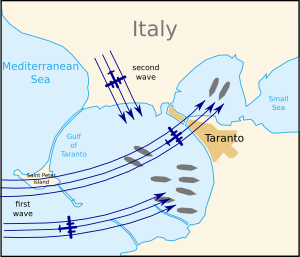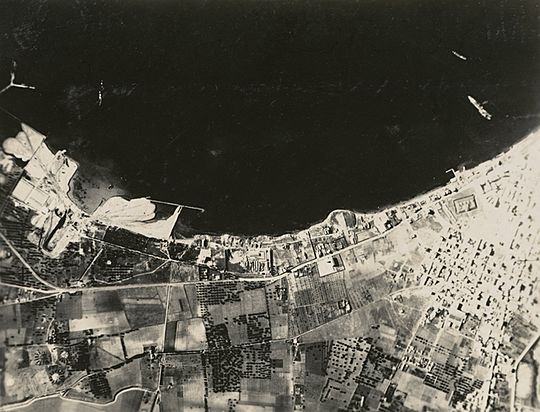Battle of Taranto facts for kids
Quick facts for kids Battle of Taranto |
|||||||
|---|---|---|---|---|---|---|---|
| Part of the Battle of the Mediterranean of World War II | |||||||
 An aerial view of the Mar Piccolo harbour in Taranto, Italy, on November 12, 1940. |
|||||||
|
|||||||
| Belligerents | |||||||
| Commanders and leaders | |||||||
| Strength | |||||||
|
|
||||||
| Casualties and losses | |||||||
|
|
||||||
The Battle of Taranto was a surprise attack by the British Navy against the Italian Navy during World War II. It happened on the night of November 11–12, 1940. The British Royal Navy, led by Admiral Andrew Cunningham, used airplanes launched from an aircraft carrier to attack Italian warships.
This was the first time in history that a naval attack was done entirely by aircraft against ships in a harbour. The British used 21 Fairey Swordfish planes, which were torpedo bombers, from the aircraft carrier HMS Illustrious. They attacked the Italian fleet, called the Regia Marina, while it was docked in the harbour of Taranto, Italy.
Even though the water in the harbour was shallow, the planes successfully used aerial torpedoes. This attack showed that planes launched from carriers could be more powerful than the big guns of battleships. Admiral Cunningham later said that Taranto proved the Navy's air power, known as the Fleet Air Arm, was its most powerful weapon.
Contents
Why the Battle Happened
For a long time, the main part of the Italian Navy had been based at Taranto. This is a port city on Italy's southeast coast. Before World War II, the British Royal Navy made plans to fight the Italian navy if a war started in the Mediterranean Sea.
When Italy joined World War II in 1940, British and Italian forces began fighting in North Africa. Italian troops in Libya needed supplies from Italy. But British ships, based in Egypt, had trouble getting supplies. The Italian navy and air force made it very risky for British ships to travel across the Mediterranean. So, British ships had to go all the way around Africa to deliver supplies.
The Italian navy often kept its warships safe in harbour. They did not want to risk losing ships in a big battle. This was because they could not easily replace any large ships that were sunk. The Italian fleet at Taranto was very strong. It included six battleships, seven heavy cruisers, two light cruisers, and eight destroyers. This made the Italian fleet a big threat to British shipping.
In 1938, a British admiral named Dudley Pound worried about his aircraft carrier, HMS Glorious, facing the Italian navy. He asked his team to review plans for attacking Taranto. Lumley Lyster, the captain of Glorious, suggested that his Fairey Swordfish planes could attack at night. At that time, the British Fleet Air Arm was the only navy air force that could do night attacks. Admiral Pound ordered training to begin for this secret plan, called Operation Judgment.
After France was defeated in 1940, the British lost the help of the French fleet in the Mediterranean. This made it even more important to weaken the Italian navy. The older British carrier, HMS Eagle, was perfect for the job. It had experienced pilots and Swordfish planes. Three Sea Gladiator fighter planes were added for the operation.
Operation Judgment was part of a larger British plan called Operation MB8. It was first planned for October 21, 1940. But a fire damaged two Swordfish planes, and the Eagle carrier had fuel problems. So, the attack was delayed.
Later, the new carrier HMS Illustrious became available. It took on five Swordfish planes from Eagle and prepared to launch the attack alone. The British naval force included Illustrious, two heavy cruisers, two light cruisers, and four destroyers. There were 24 Swordfish planes ready for the attack. Some worried that such a small number of planes would only make the Italian Navy angry without doing much damage.
Half of the Swordfish planes carried torpedoes. The other half carried bombs and flares to create diversions. The torpedoes were designed to explode on contact or magnetically. There was a concern that the torpedoes might hit the bottom of the shallow harbour. The British expected to lose half of their planes in the attack.
British planes from Malta flew reconnaissance missions to confirm where the Italian fleet was. These flights showed that the Italians had barrage balloons protecting the harbour. The British changed their attack plan because of this. On the night of November 11, a British Short Sunderland plane flew over Taranto. This flight warned the Italian forces, but they had no radar to find the British ships. The Italian navy could have sailed out to search for the British, but their strategy was to stay in port.
The British Operation MB8 was complex and tricked the Italians into thinking it was just a normal convoy operation. This helped the Taranto attack succeed.
Taranto harbour had defenses, including 101 anti-aircraft guns and 193 machine guns. It was also supposed to have barrage balloons to protect against low-flying planes. But strong winds had blown away many balloons, so only 27 were in place. Italian battleships were also meant to be protected by anti-torpedo nets. However, only about one-third of the needed nets were in place. Also, these nets did not reach the bottom of the harbour, allowing British torpedoes to pass underneath them.
The Attack
The first group of 12 planes left Illustrious just before 9:00 PM on November 11, 1940. A second group of nine planes followed about 90 minutes later. One plane from the second group turned back, and another was delayed. So, only eight planes from the second group reached the target.
The first group of planes split up. The main group approached the harbour at Mar Grande at 10:58 PM. They dropped flares to light up the area. Then, some planes attacked oil tanks. Three planes attacked the battleship Conte di Cavour. One torpedo hit the ship, making a large hole in its side. The plane that hit the Conte di Cavour was shot down by Italian anti-aircraft guns. The other two planes tried to attack the battleship Andrea Doria but missed.
Another group of three planes attacked from a different direction. They hit the battleship Littorio with two torpedoes. They also launched a torpedo at the battleship Vittorio Veneto, but it missed. Other planes dropped bombs, hitting two cruisers and nearly hitting four destroyers.

The second group of eight planes approached the harbour. They dropped flares just before midnight. Two planes aimed torpedoes at Littorio, and one hit. Another plane, even though it was hit by anti-aircraft fire, aimed a torpedo at Vittorio Veneto, but it missed. Another plane hit the battleship Duilio with a torpedo, causing a big hole and flooding parts of the ship. One plane from the second group was shot down after hitting Littorio. The last plane to arrive made an unsuccessful bombing attack on a cruiser and then returned safely to Illustrious.
Of the two British planes shot down, the pilot and observer of the first plane were captured. The pilot and observer of the second plane were killed.
The Italian battleships were badly damaged:
- The Conte di Cavour had a large hole in its side. It sank to the bottom of the harbour. Many crew members were killed or wounded. The ship was later raised and partially repaired, but it never returned to full service.
- The Duilio also had a large hole and was saved by being run aground (moved to shallow water to prevent sinking).
- The Littorio was hit by three torpedoes and had a lot of flooding. It was also saved by being run aground. Its front part was completely underwater by morning.
The Italian defenses fired many shells from land batteries and ships. There were 101 guns and 193 machine guns firing. Only a small amount of anti-torpedo nets were protecting the ships. The British planes were successful despite the strong defenses.
The Littorio was repaired in about four months. The older battleships took much longer to fix. The Duilio took seven months, and the Conte di Cavour was never fully repaired. In total, only 20 British planes caused this damage. Two Italian planes were destroyed on the ground. Some bombs also damaged a cruiser and a destroyer.
Meanwhile, other British ships attacked an Italian convoy. They sank four Italian merchant ships and damaged a torpedo boat.
The British wanted to attack Taranto again the next night, but bad weather stopped them.
What Happened Next
The Italian fleet lost half of its main warships in one night. The next day, the Italian Navy moved its undamaged ships from Taranto to Naples. They wanted to protect them from more attacks until the defenses at Taranto were improved. This happened between March and May 1941.
Admiral Cunningham felt that the British now had a big advantage. He believed the remaining Italian battleships would not want to fight. The balance of power in the Mediterranean had shifted to the British. They could now split their fleet into two groups, each with an aircraft carrier and two battleships.
However, the Italians did risk their remaining ships soon after. Just five days after Taranto, Italian ships sailed out to stop British planes from reaching Malta. This led to another battle later in November 1940. Two of the three damaged Italian battleships were repaired by mid-1941. Control of the Mediterranean Sea continued to change hands until Italy surrendered in 1943.
The Italian Navy got revenge a year later in the Raid on Alexandria. They used midget submarines to attack the British fleet, severely damaging two British battleships.
Even though the Taranto attack was a big victory, it did not stop Italian supply convoys to Africa very much. In fact, Italian shipping to Libya actually increased in the months after the attack. So, while it was a clever attack, it didn't completely change the war in the Mediterranean.
Before this battle, experts thought that torpedoes could only be used in water at least 75 feet deep. But Taranto harbour was only about 39 feet deep. The British had found a new way to stop their torpedoes from diving too deep. They used a special wire that pulled the torpedo's nose up as it dropped, making it hit the water more flatly.
How it Influenced Pearl Harbor
The Imperial Japanese Navy likely studied the Taranto attack very carefully when planning their attack on Pearl Harbor. Both attacks involved striking ships in shallow harbours. A Japanese officer even visited Taranto to see the damage firsthand. He later talked with Commander Mitsuo Fuchida, who led the Japanese attack on Pearl Harbor.
However, the Japanese had been working on ways to use torpedoes in shallow water since 1939. They had developed special wooden parts for their torpedoes to make them stable and prevent them from diving too deep.
The Japanese attack on Pearl Harbor on December 7, 1941, was much larger than Taranto. Six Japanese aircraft carriers took part, each with more than twice the number of planes as a British carrier. The attack caused much more damage. Seven American battleships were sunk or badly damaged. After Pearl Harbor, the U.S. Navy started to build its fleet around aircraft carriers instead of battleships. Battleships were found to be less useful in the vast Pacific Ocean.
Images for kids







